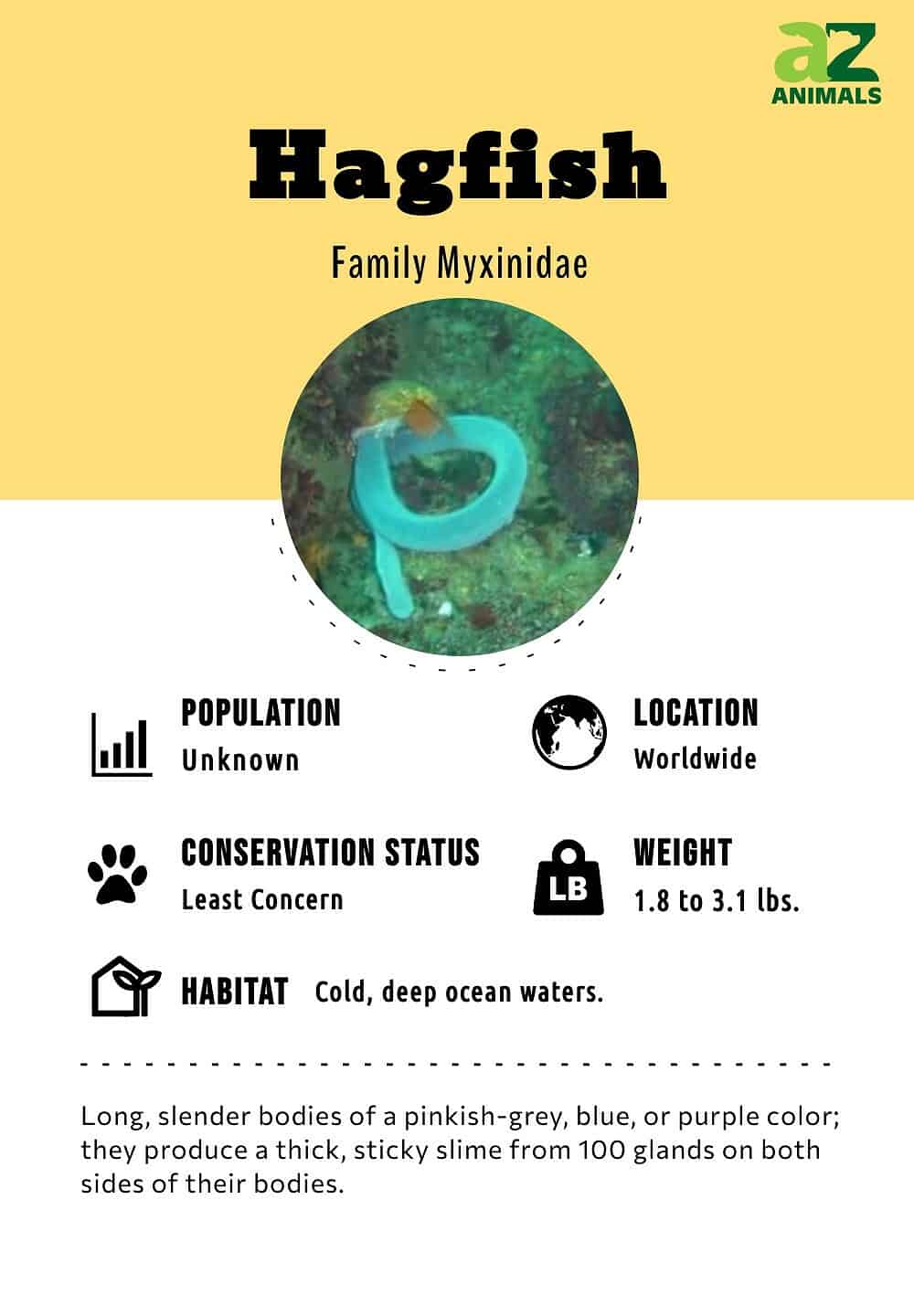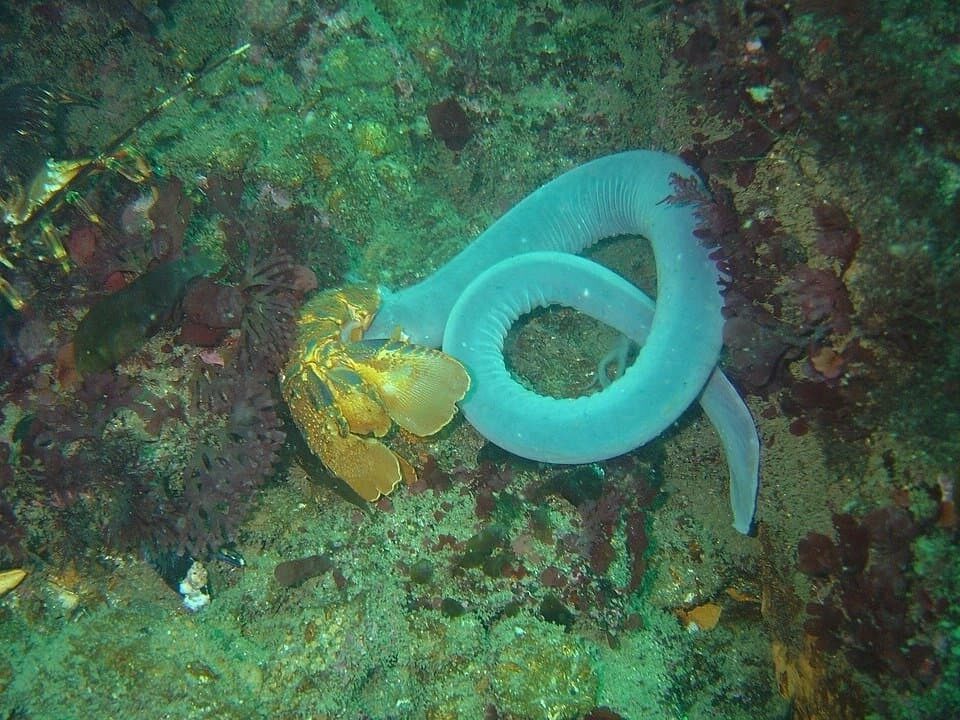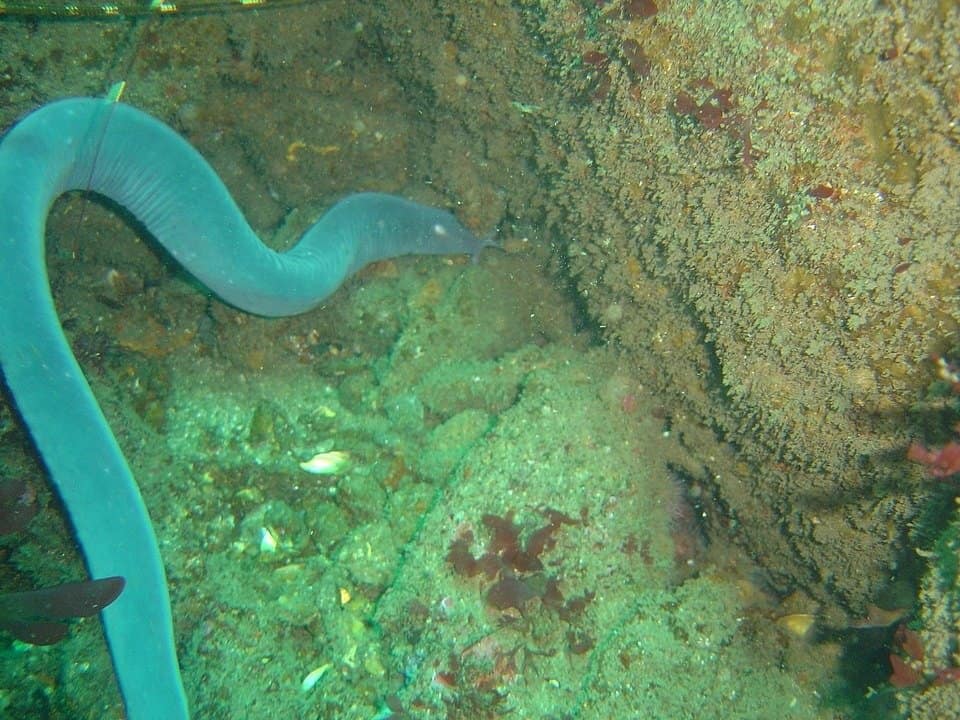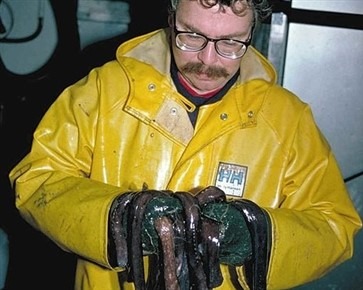Can use slime to suffocate marine predators or escape capture
Advertisement
Hagfish Scientific Classification
Read our Complete Guide to Classification of Animals.
Hagfish Conservation Status
Hagfish Facts
- Prey
- Bottom-dwelling invertebrates
- Group Behavior
- Solitary
- Fun Fact
- Can use slime to suffocate marine predators or escape capture
- Estimated Population Size
- Unknown
- Biggest Threat
- Harvesting for leather and food
- Most Distinctive Feature
- Slime
- Other Name(s)
- Slime eel, slimy eel
- Habitat
- Every ocean
- Predators
- Birds, mammals
- Diet
- Carnivore
- Type
- Vermiform
- Common Name
- Hagfish
- Number Of Species
- 82
View all of the Hagfish images!
Hagfish are widely considered the most disgusting animals in the ocean.

Hagfish, also known as slimy eels or slime eels, are so named because they produce slime. However, they are not actually eels but eel-like fish that have jawless mouths, like the lampreys. They are important for commercial and food purposes, and their habitat is all the world’s oceans, with each species having a different range.
5 Incredible Facts!
- Hagfish are the only animals that have a skull but no spinal column, although they do have rudimentary vertebrae.
- They can absorb nutrients through their skin.
- Their slime allows them to escape capture when they tie themselves into an overhand knot.
- Their slime clogs up marine predators’ gills, suffocating them so they will release the hagfish.
- The hagfish’s loose skin allows for whole-body flexibility that allows tying itself into knots without injury.
Classification and Scientific Name

Hagfish are the only animals have a skull but no vertebral column, yet their rudimentary vertebrae get them into the subphylum
Vertebrata.
©Frank Fennema/Shutterstock.com
The hagfish belongs to the subphylum Vertebrata because, although they have no spinal column, they have rudimentary vertebrae. Then the hagfish is in the superclass Cyclostomata and the class Myxini; however, they were once in the historical class called Agnatha, for jawless fish (agnathans), with lampreys. Classification names and members have been adjusted through the years as more is learned about the various life forms and their characteristics.
The order is Myxiniformes. There is only one family of hagfish, Myxinidae, but there are six genera. Sometimes, they are classified into two families, the other being Eptatretidae. All the species have the common characteristics of a jawless mouth and a cartilaginous skull with no spinal column.
The six genera are: Myxini, Eptatretus, Paramyxine, Notomyxine, Neomyxine, and Nemamyxine.
There are approximately 70-82 species, with the number varying because of the continuous discovery of new species. The most studied species, with the scientific name Myxini glutinosa, is the Atlantic hagfish. Examples of other species are the Goliath (Eptatretus goliath), Pacific or California hagfish (Eptatretus stoutii), and the black hagfish (Eptatretus deani).
There is a hagfish fossil from 300 million years ago, and scientists think that the hagfish has not changed much in all that time.
Appearance

All the hagfish species have long, slender bodies with a pinkish-grey, blue or purple color, depending on the species.
All the hagfish species have the common characteristics of long, slender bodies with a pinkish-grey, blue or purple color depending on the species, and sometimes covered in spots. They all also produce a thick, sticky slime from 100 glands on both sides of their bodies. Their weight ranges from 0.85 to 1.4 kg (1.8 to 3.1 lb) with a length of 4cm (1.6in)-81.28cm (32in), but typically 50cm (19.7in)
There are several other unique characteristics:
- Hagfish are one of the few animals that have multiple hearts. They possess three accessory hearts, no cerebrum or cerebellum, a single nostril, and a cartilaginous skull.
- They have a tooth plate that protracts and retracts in lieu of jaws; 2 parallel rows of rudimentary, pointed teeth which repeatedly get re-absorbed and regrown; a rasping tongue; and a horizontally moving, funnel-shaped mouth.
- Hagfish have several pairs of tentacles in various places on the body serve mechanosensory and chemosensory functions.
- They have a reduced pair of eyes appearing as pigmented spots on the back of the head behind the oral region, under the translucent skin, and in front of the gill-bearing branchial region.
- What differentiates these fish from eels is the lack of paired fins, since they have only the caudal (tail) fin.
- Internally, their respiratory system is unique, with the presence of a sinus system through which the organs absorb blood from the veins and other blood vessels.
- They have no stomach but the food they consume is instead enclosed in a permeable membrane.
The Atlantic hagfish can grow up to 95 cm (37.4 in) in length while the Goliath Hagfish, the largest species, can reach 127.5 cm (4 ft, 4 in). Myxine kuoi and Myxine pequenoi reach up to 18 cm (7.1 in), while other species are as small as 4 cm (1.6 in).
The species of the genus Eptatretus are seven-gilled hagfishes. The Atlantic and Pacific hagfish differ in two ways: The Atlantic hagfish has muscle fibers in its skin, and its resting position is stretched, while that of the Pacific hagfish is coiled.
Behavior

Hagfish live on or near the bottom of the ocean floor.
Although the thick, sticky substance hagfish produce is called slime, it’s actually not. Its characteristics are instead a milky, fibrous mucus. The species Myxini glutinosa was named for it, with the word “glutinosa” in Latin meaning glutinous or gummy. Hagfish produce slime while they eat, while burrowing, or while escaping from predators in conjunction with an overhand knot from head to tail. The slime is often used as a substitute for egg whites.
Since hagfish live on or near the bottom of the ocean floor, fishing is difficult near them. They can spoil or consume the catches within fishers’ deep dragnets before they can pull them to the surface.
Distribution, Population, and Habitat
The population of all hagfish species is unknown, but these fish are present in all the world’s oceans. All species live in cold saltwater, with their range or ocean varying depending on the species. The habitat of the species in the Eptatretus genus is the Pacific Ocean, with that of the Far Eastern inshore hagfish (Eptatretus burgeri) being the Northwest Pacific. The habitat of the Myxinidae family is all the world’s oceans, and that of Eptatretidae is everywhere except the North Atlantic. They burrow into the ocean floor or into dead and dying fish, living in cold, low waters with a temperature of 15°C and depth range of 52-5,600ft (15.85-1,800m), but typically 4,000ft (1,219m).
Predators and Prey
Hagfish are scavengers and parasitic, with a carnivorous diet. They prefer to feed on or parasitize live prey, although they will scavenge on dead or dying creatures when given the opportunity. Their rasping tongues pull the prey into their mouths.
Hagfish typically feed on bottom-dwelling worms and other invertebrates, whales, and fish. They can absorb nutrients through their skin and produce slime when they feed.

Hagfish are eaten in some cultures, and used as a durable leather.
Hagfish have few marine predators because of their slime, which helps them to escape predators, as well as the ability to squeeze through openings that are less than half their body width, which not only helps them to escape predators but to scavenge. Their predators are mostly varieties of birds and mammals, with humans posing a threat to 20% of the population according to the IUCN.
Reproduction and Lifespan
Hagfish are a sexually dimorphic species with a ratio of up to 100:1 in favor of females. Some species are hermaphroditic. Females lay anywhere between 1-30 tough eggs that stick to each other with Velcro-like ends. The gestation period is typically 11 months, and there is no larval stage, unlike lampreys. Not much else is known about their reproductive behavior due to the difficulty in laboratory breeding. Regardless, they can live up to 40 years in the wild and 17 in captivity.
Fishing and Cooking
Hagfish have important commercial uses.
For one, they are eaten in Korea and Japan. In Korea, they are typically skinned before being grilled or stir-fried and are considered an aphrodisiac by the men. In Japan, hagfish serve as an alternative to tofu, due to the slime that can bind a large amount of liquid with little to no heating. Curious eaters can obtain hagfish in the United States from fishers in California.
Hagfish flesh is chewy with a mild yet distinct taste and an unpleasant aftertaste. To prepare Korean-style, slice down the middle, remove the digestive tract, and marinate in Korean barbecue sauce. Place the raw fish on a hot plate and cook, slicing with scissors, and serve the cooked fish with lettuce and gochujang (red chili paste). The head is typically left on the fish and offered as an honor to guests. Alternately, the fish can be eaten raw, and are popular in their raw form.
Hagfish skin is used as a durable leather in several clothing accessories including wallets, belts and shoes. It is typically called “eel skin.”
View all 104 animals that start with HHagfish FAQs (Frequently Asked Questions)
What is a hagfish?
A hagfish is an eel-like, jawless fish.
Where do hagfish live?
Hagfish live in all oceans, with their habitat range depending on the species.
What do hagfish eat?
Hagfish eat worms and other invertebrates, fish, and whales.
What is hagfish slime used for?
It is an egg white substitute.
Can you eat hagfish?
Yes, you can eat hagfish, but it is an acquired taste.
What Kingdom do Hagfish belong to?
Hagfish belong to the Kingdom Animalia.
How do Hagfish have babies?
Hagfish lay eggs.
What are the differences between olive sea snakes and hagfish?
The key difference between the olive sea snake and the hagfish is that olive sea snakes are reptiles, and hagfish are fish. Olive sea snakes breathe air, whereas hagfish breathe water. Hagfish live on the murky ocean bottom and have no jaws, whereas olive sea snakes live among coral reefs and have jaws.
What are the differences between lampreys and hagfish?
The key difference between lampreys and hagfish is that lampreys have uniquely adapted mouths for getting nutrients from their prey’s blood while hagfish are scavengers. While the two fish are superficially very similar, they have differences in terms of diet, defense mechanisms, and anatomy.
What are the key differences between an orca and a hagfish?
The greatest differences between an orca and a hagfish can be found in their size and morphology. The hagfish resembles a small eel that measures between 1 and 32 inches and weighs up to 3.1 pounds, and the orca is the largest member of the dolphin family, weighing up to 12,000 pounds and growing up to 26 feet in length.
Thank you for reading! Have some feedback for us? Contact the AZ Animals editorial team.
Sources
- Wikipedia / Accessed December 20, 2020
- Aquarium of the Pacific / Accessed December 20, 2020
- Smithsonian Magazine / Accessed December 20, 2020
- Wired / Accessed December 20, 2020
- Berkeley University / Accessed December 20, 2020
- Animals / Accessed December 20, 2020
- Britannica / Accessed December 20, 2020
- Alaska Department of Fish and Game / Accessed December 20, 2020
- Wiley Online Library / Accessed December 20, 2020
- IUCN / Accessed December 20, 2020
- Loveland Living Planet Aquarium / Accessed December 20, 2020
- Sea and Sky / Accessed December 20, 2020
- Owlcation / Accessed December 20, 2020
- Your Article Library / Accessed December 20, 2020


















